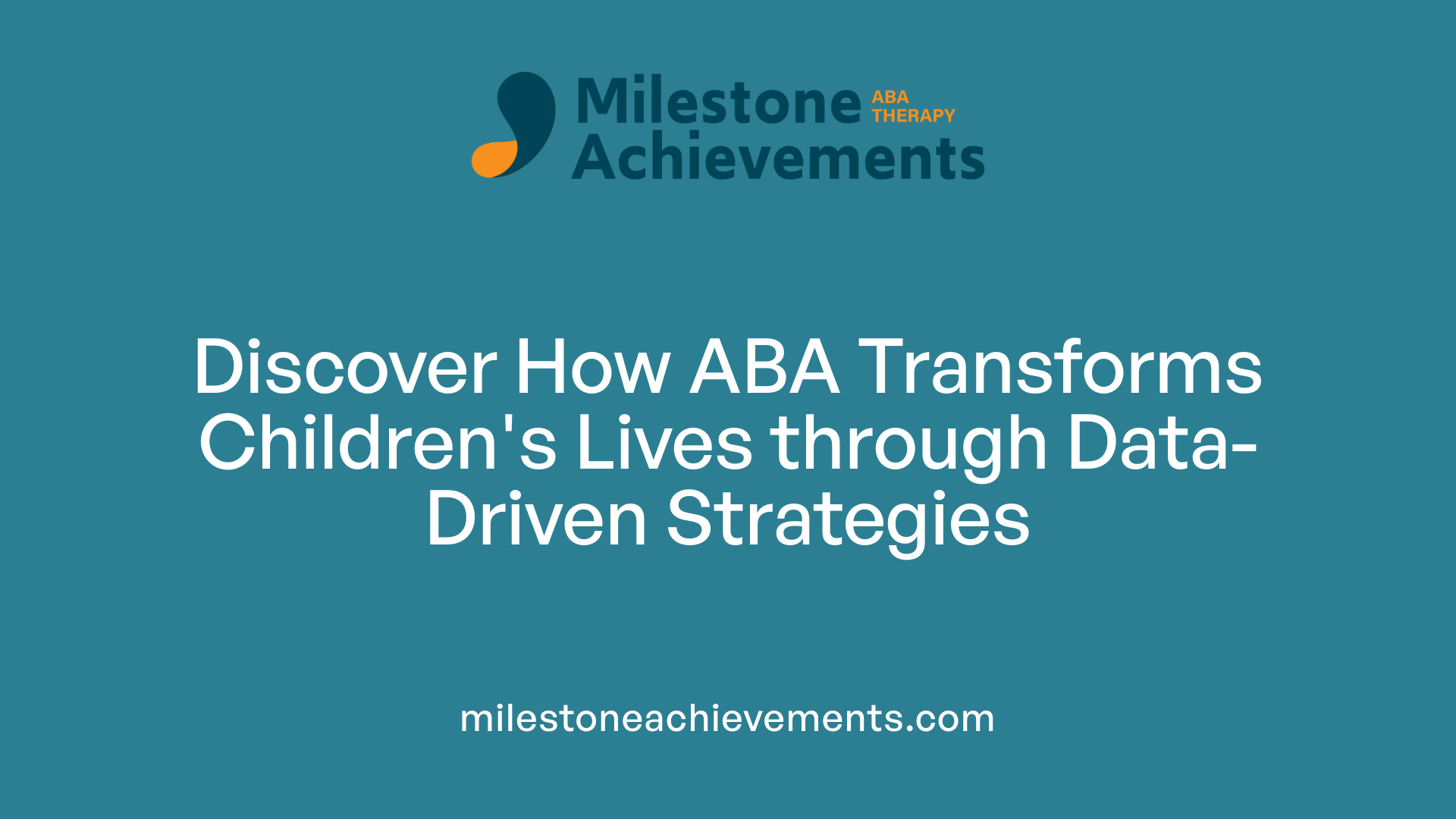
ABA for Social Anxiety in Kids
Understanding Therapeutic Approaches for Childhood Social Anxiety
A Comprehensive Look at ABA and Its Role in Managing Children's Social Anxiety
Social anxiety can significantly impact a child's social development, self-esteem, and overall well-being. Among various treatment options, Applied Behavior Analysis (ABA) has emerged as a promising, evidence-based approach. This article explores how ABA therapy can be tailored to help children manage social anxiety effectively, highlighting techniques, strategies, and the importance of early intervention.
What is ABA Therapy and How Does It Help?

What is ABA therapy?
Applied Behavior Analysis (ABA) therapy is an evidence-based intervention that focuses on understanding the causes of behaviors and teaching functional alternatives. It is widely used to support children with Autism Spectrum Disorder (ASD) and related conditions. Through systematic assessment and personalized goals, ABA helps children develop better social, communication, and self-regulation skills.
Evidence-based nature of ABA
ABA therapy is backed by extensive research demonstrating its effectiveness. It involves data collection, behavioral assessments, and tailored interventions that adapt to each child's unique needs. Practitioners use positive reinforcement, structure, and behavior modification techniques to promote positive interactions and reduce problematic behaviors.
How ABA examines behavior causes and teaches alternatives
This approach involves analyzing behaviors to identify triggers and underlying causes. Once understood, children are taught functional alternatives that serve the same purpose but are more appropriate or adaptive. For example, teaching a child to ask for help instead of exhibiting a meltdown when overwhelmed.
What is ABA for social anxiety?
In cases of social anxiety, ABA focuses on modifying avoidance behaviors, encouraging positive social interactions, and gradually exposing children to social situations. Techniques such as systematic desensitization, positive reinforcement, and functional analysis are employed to identify triggers and build confidence.
How ABA helps with anxiety and social skills
ABA strategies can help reduce anxiety by teaching coping skills, relaxation techniques, and problem-solving methods. Desensitization procedures involve gradually exposing children to stressful stimuli, such as pictures or real-life social interactions, to decrease anxiety responses. Additionally, ABA supports social skill development by teaching necessary skills and promoting participation in social settings.
Parent involvement and individualized support
Parental involvement is crucial for the success of ABA therapy, enabling children to generalize skills across various settings. Therapy sessions are personalized, utilizing behavioral assessments to define specific goals. For example, teaching children how to manage routines or tolerate medical procedures like nail cutting.
Combining ABA with other therapies
ABA can be combined with speech and occupational therapy to address communication and self-regulation issues, further helping to mitigate anxiety levels. Overall, ABA offers a comprehensive approach to managing many challenges associated with ASD, including anxiety, with approximately 40% of young people with ASD experiencing clinically elevated anxiety.
This targeted, data-driven framework helps children learn coping skills, express themselves positively, and engage more confidently in social and daily activities, significantly improving their quality of life.
Key Techniques Used in ABA for Anxiety Management

What techniques are used in ABA to manage anxiety?
ABA therapy incorporates several methods to help children manage their anxiety effectively. These techniques include cognitive restructuring, systematic desensitization, and relaxation strategies.
One of the primary methods is systematic desensitization. This approach involves gradually exposing the child to anxiety-provoking stimuli, such as pictures, videos, or real-life interactions. The goal is to help the child become more comfortable with these triggers over time, reducing their anxiety levels.
Cognitive restructuring is another technique used within ABA to help children identify and challenge negative thought patterns that contribute to anxiety. By learning to reframe their thoughts, children can develop a more positive outlook and increased resilience.
Relaxation techniques are also integrated into ABA sessions to teach children ways to calm their minds and bodies during stressful situations. These may include deep breathing exercises, progressive muscle relaxation, or mindfulness practices.
Together, these strategies provide a comprehensive approach to reducing anxiety, helping children develop coping skills and participate more fully in social and daily activities.
Tailoring ABA Interventions to Individual Needs

How is ABA personalized for children with social anxiety?
ABA therapy is highly individualized to meet each child's unique needs, especially for those experiencing social anxiety. The process begins with comprehensive behavioral assessments, where practitioners observe and analyze the child's specific behaviors, triggers, and responses.
Using this information, data collection methods are employed to record ongoing behaviors and progress. This data might include frequency counts, duration, or intensity of specific actions, providing a clear picture of the child's anxiety levels and social challenges.
Based on these assessments, therapists set customized goals aimed at improving social skills and reducing anxiety. For example, a child struggling with initiating conversations may have goals focused on building confidence in social interactions.
Throughout the therapy, interventions are adapted to fit the child's evolving needs, incorporating techniques like desensitization, relaxation strategies, and positive reinforcement.
Personalized ABA strategies ensure that each child gains practical skills tailored to their particular anxieties, promoting better social participation and emotional regulation.
| Step | Approach | Purpose | Additional Details |
|---|---|---|---|
| 1 | Behavioral assessments | Identify specific anxiety triggers | Includes direct observations and caregiver interviews |
| 2 | Data collection methods | Track behavior changes | Techniques include frequency and duration recording |
| 3 | Customized goal setting | Target individual challenges | Goals are specific, measurable, and attainable for each child |
These personalized strategies make ABA a flexible and effective approach for managing childhood anxiety, especially when combined with parent involvement and other therapies like speech or occupational therapy.
Role of Parent Involvement and Generalization of Skills
How can parents support ABA therapy for social anxiety?
Parent involvement plays a vital role in the success of ABA therapy, especially in addressing social anxiety. Educating parents about reinforcement techniques, social skills training, and maintaining consistent routines helps children apply learned behaviors beyond therapy sessions.
Parents can support skill generalization by practicing social interactions at home and in community settings. This consistent reinforcement helps children feel more comfortable and confident in various environments.
Furthermore, parents are encouraged to track progress, collaborate regularly with therapists, and adapt strategies to suit their child's evolving needs. This active involvement ensures that behavioral improvements are sustained and applied in everyday life.
Addressing Specific Anxiety Triggers and Signs

Observable signs of anxiety
Children with anxiety may display various signs that parents and caregivers can observe. These include physical symptoms such as increased heart rate, fidgeting, or sweating. Vocal expressions like crying or whining, as well as behaviors such as avoiding social interactions or routines, are also common. Recognizing these signs early can alert caregivers to potential anxiety issues.
Identifying specific triggers
ABA therapy emphasizes pinpointing what causes a child's anxiety. Therapists observe behaviors closely and conduct functional assessments to understand the triggers. These triggers could be environmental, such as unfamiliar settings or loud noises, or routine changes, like switching activities or routines. By identifying these triggers, ABA practitioners can tailor interventions to help children better cope.
Behavioral interventions
Once triggers and signs are identified, ABA employs targeted strategies to reduce anxiety. Techniques such as systematic desensitization gradually expose children to stressful stimuli in a controlled manner, helping them build tolerance over time. Cognitive restructuring teaches children to challenge anxious thoughts, while relaxation techniques, including deep breathing, help manage physiological symptoms.
How does ABA identify and address anxiety triggers?
ABA practitioners focus on recognizing observable signs of anxiety and understanding individual triggers. Through functional analysis, they develop targeted interventions that reduce trigger occurrence and help children adopt coping mechanisms, thereby decreasing overall anxiety.
Customizing support
Behavior interventions are personalized, using data collection and behavioral assessments to set specific goals. Parent involvement is essential, as it allows children to practice new skills across different settings, reinforcing their ability to manage anxiety in real-world situations.
| Aspect | Approach | Details |
|---|---|---|
| Signs of anxiety | Observation | Physical and behavioral indicators observed by caregivers |
| Trigger identification | Functional analysis, assessment tools | Finding environmental or routine-related causes |
| Interventions | Desensitization, cognitive strategies, relaxation techniques | Tailored activities to reduce anxiety triggers and build skills |
| Parental involvement | Training, consistent practice | Supports skill generalization and comfort across settings |
Using Desensitization for Routine and Medical Procedure Tolerance
How does ABA help children tolerate routines and procedures?
ABA therapy uses desensitization techniques to assist children in becoming more comfortable with routines and medical procedures. This approach involves gradually exposing children to the activities they find stressful, such as changing routines or nail cutting.
During these sessions, children are first introduced to a simple version of the activity, like looking at pictures or videos related to the routine. As they become more comfortable, the exposure increases to real-life interactions, always paired with positive reinforcement, such as praise or preferred activities.
This step-by-step process helps to build resilience, reducing the child's anxiety and distress. Over time, children learn to tolerate these activities with less fear, making daily routines and medical procedures smoother and less distressing for everyone involved.
Specific applications of ABA desensitization
- Routine changes, such as adjusting to new schedules or different environments.
- Medical procedures like nail cutting, injections, or doctor visits.
- Other daily routines that a child may resist or find upsetting.
Effectiveness of ABA techniques
Research and clinical practice support the effectiveness of ABA desensitization in helping children manage their anxiety around everyday activities. By breaking down complex or stressful procedures into manageable steps, children can develop coping strategies that transfer to various settings.
Overall, ABA emphasizes patience, consistency, and individual tailoring to ensure each child's success in tolerating essential routines and procedures.
Integration of ABA with Other Therapies
ABA therapy is often most effective when combined with other supportive interventions like speech therapy and occupational therapy. These approaches target different areas such as communication skills and self-regulation, which are closely linked to anxiety management.
Speech therapy can help children improve their ability to express themselves clearly and understand others better. Enhanced communication skills can reduce social misunderstandings and decrease feelings of anxiety, especially in social settings.
Occupational therapy focuses on developing skills to regulate emotions, improve sensory processing, and manage daily routines. These areas are crucial for children with ASD who may experience heightened anxiety due to sensory sensitivities or difficulty with routine changes.
Can ABA be combined with other therapies for social anxiety? Yes, ABA therapy can be integrated with speech therapy and occupational therapy to address communication issues and self-regulation difficulties. This holistic approach not only improves overall social functioning but also helps reduce anxiety levels. Better communication and emotional regulation enable children to participate more fully in social activities, fostering confidence and decreasing social fears.
When these therapies are used together, they complement each other by targeting multiple facets of a child's development. ABA techniques, such as positive reinforcement and behavior modification, are applied alongside speech and occupational strategies, creating a comprehensive support system.
Research indicates that this integrated approach can lead to significant improvements in anxiety levels, communication abilities, and daily functioning. Tailoring interventions to each child's unique needs ensures more meaningful progress.
| Therapy Type | Focus Area | Benefit | How It Supports ABA Therapy |
|---|---|---|---|
| Speech Therapy | Communication skills | Better self-expression and understanding | Enhances social interactions, reducing social anxiety |
| Occupational Therapy | Sensory processing, self-regulation | Increased ability to manage routines and emotions | Complements ABA strategies by addressing sensory sensitivities |
| Combined Approach | Social skills, emotional regulation | Overall reduction in anxiety and improved social participation | Provides a well-rounded framework fostering independence |
Integrating these therapies creates a comprehensive plan tailored to each child's specific needs, resulting in more effective management of anxiety and related challenges.
ABA's Role in Reducing Anxiety and Promoting Positive Behaviors
How does ABA help in reducing anxiety in children?
ABA therapy plays a significant role in helping children manage anxiety by teaching them essential coping skills. Through tailored interventions, children learn to express themselves positively and develop problem-solving abilities, which reduce feelings of distress.
The therapy employs positive reinforcement, rewarding desired behaviors to encourage their recurrence. Structured sessions and behavioral assessments allow practitioners to identify triggers and implement specific strategies that help children feel more in control of their reactions.
Developing coping skills
One of the core aspects of ABA is teaching children various coping techniques. These include relaxation methods, cognitive restructuring, and desensitization procedures. For example, gradual exposure to stressful stimuli—such as pictures, videos, or real-life situations—helps children become accustomed to anxiety-provoking triggers, decreasing their sensitivity over time.
ABA also emphasizes understanding individual signs of anxiety so that interventions can be precisely targeted. This personalized approach ensures children acquire effective skills to handle routines, medical procedures, and social interactions with greater ease.
Positive reinforcement strategies
ABA practitioners widely use positive reinforcement to encourage behaviors that help reduce anxiety. For instance, children might be rewarded for attempting a new social activity or tolerating a change in routine. This approach helps build confidence and promotes continued progress.
In addition, reinforcement strategies are integrated with other techniques such as systematic desensitization, which involves gradually increasing exposure to triggers to build tolerance.
Problem-solving techniques
A vital component of ABA therapy is teaching children to approach problems confidently. This includes guiding them to recognize challenges, think of solutions, and implement appropriate actions. Problem-solving skills are reinforced through role-playing, visual aids, and real-world practice.
Parents are encouraged to participate actively, helping children generalize these skills beyond therapy sessions into everyday life settings.
| Technique | Description | Example |
|---|---|---|
| Systematic Desensitization | Gradual exposure to anxiety triggers | Tolerating nail cutting through step-by-step routines |
| Relaxation Training | Teaching calm breathing and mindfulness | Practice deep breathing during stressful situations |
| Cognitive Restructuring | Changing negative thought patterns | Replacing fear-based thoughts with positive statements |
| Reinforcement Strategies | Rewarding positive behaviors | Praising a child for joining a social activity |
By combining these tailored strategies, ABA therapy effectively helps children with ASD manage anxiety, improve their social participation, and develop healthier relationships and routines.
Recognized Effectiveness and Broader Benefits of ABA

Research findings
Several studies support the positive impact of Applied Behavior Analysis (ABA) therapy on children with autism spectrum disorder (ASD), particularly those experiencing anxiety. Research suggests that roughly 40% of young people with ASD face elevated levels of anxiety or at least one anxiety disorder. ABA therapy, an evidence-based approach, helps by examining the causes of behaviors and teaching functional, positive alternatives.
Application to ASD and anxiety
ABA therapy is highly adaptable, tailoring interventions to each child's unique needs. It involves data collection, behavioral assessments, and setting customized goals. Techniques such as cognitive restructuring, desensitization, and relaxation strategies are employed to reduce anxiety.
Behavioral improvements
Through structured sessions and positive reinforcement, ABA practitioners teach children coping skills, relaxation techniques, and problem-solving strategies. For example, systematic desensitization gradually exposes children to stressful stimuli like pictures, videos, or real-life situations, helping them tolerate changes in routines or medical procedures such as nail cutting.
Furthermore, ABA can help lessen social anxiety by teaching essential social skills and encouraging participation in social settings. This approach not only reduces avoidance behaviors but also promotes positive interactions and emotional regulation.
Effectiveness of ABA therapy for social anxiety
Research indicates that ABA therapy effectively decreases avoidance behaviors and enhances social participation. It is widely recognized for managing complicating factors like anxiety within ASD, helping children develop more positive interactions and better emotional regulation. Involving parents in the process further supports skill generalization across different environments.
| Aspect | Application/Benefit | Additional Details |
|---|---|---|
| Anxiety reduction | Teaching coping skills, relaxation, and desensitization | Gradual exposure to stressors, coping strategies taught |
| Social skills development | Improving social interaction and reducing social anxiety | Promoting participation in social settings, positive reinforcement |
| Customization | Tailored to individual needs through assessments and data | Personalized goals and interventions |
| Parent involvement | Enhances generalization and supports skill retention | Active participation in therapy sessions |
In summary, ABA therapy’s structured and individualized approach makes it a practical and effective option for reducing anxiety and improving social behaviors in children with ASD.
Early Diagnosis, Intervention, and Overall Impact
Why is early diagnosis and treatment important?
Early diagnosis and intervention play a vital role in managing childhood anxiety effectively. When behavioral issues and anxiety are identified promptly, tailored therapies like ABA (Applied Behavior Analysis) can be introduced at an early stage. This proactive approach allows for adjustments that target specific triggers and develop coping strategies, which are essential in reducing anxiety levels.
Implementing ABA therapy early on helps children learn functional alternatives to anxiety-driven behaviors. It also facilitates skill development in social interactions and self-regulation. Data collection and behavioral assessments guide customized goals, ensuring interventions are relevant to each child's unique needs.
Research indicates that early treatment significantly enhances social functioning and emotional resilience. It diminishes long-term complications associated with anxiety, leading to healthier development trajectories. Moreover, early intervention often involves parents, which reinforces learning and skill generalization across different settings.
Developmental benefits of early ABA intervention
When ABA therapy begins early, children gain important social and communication skills that support their overall development. Techniques such as teaching social skills, cognitive restructuring, and desensitization—exposing children gradually to stressful stimuli—help reduce anxiety. For example, systematic desensitization might involve gradually increasing exposure to situations like medical procedures, which are often sources of distress.
Parents’ involvement in therapy is crucial. It helps children practice new skills outside of sessions, making progress more consistent. In addition, combining ABA with other therapies such as speech or occupational therapy further addresses underlying communication and self-regulation challenges, important factors influencing anxiety.
Long-term outcomes for children receiving early ABA therapy
Children who start ABA interventions early tend to experience better long-term outcomes. They are more likely to develop adaptive coping skills, participate confidently in social settings, and manage changes in routines or environments, reducing anxiety triggers.
Research suggests that about 40% of young people with Autism Spectrum Disorder (ASD) experience significant anxiety. Early ABA therapy can mitigate these issues by teaching problem-solving, positive self-expression, and self-calming techniques.
Overall, timely diagnosis and personalized ABA treatment create a foundation for less anxious, more resilient future generations, demonstrating the lasting impact of early mental health support.
Empowering Children Through Evidence-Based Therapy
ABA therapy offers a personalized, effective approach to help children manage social anxiety. Its focus on behavior modification, skill-building, and involving families makes it a vital component of comprehensive treatment plans. Early intervention and tailored strategies can significantly improve social confidence and emotional well-being, enabling children to thrive in their social environments.
References
- Can ABA Therapy Help with Anxiety? In Many Cases, Yes
- Autism and Anxiety: A Comprehensive Guide to How ABA Helps
- Pediatric Social Phobia - Conditions and Treatments
- Children's National Hospital - Ranked Top 10 in the Nation
- Anxiety Disorders Program | Children's National Hospital
- Pediatric Generalized Anxiety Disorder - Conditions and Treatments
- What Is the 333 Rule for Anxiety? - Stella Center
- The 333 Rule for Anxiety - MentalHealth.com
- Stella Resources - The Latest Info On SGB, Ketamine & More
- Alternative Treatment For Anxiety - Stella Center


Partner with us on your child's journey
Milestone Achievements offers evidence-based ABA therapy to help children with autism reach their full potential. Together we’ll set meaningful goals and celebrate progress every step of the way.
Start ABA Services Today


